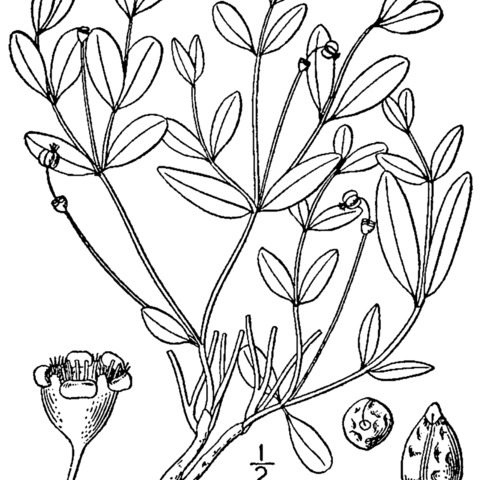Herbs, perennial, with deep, stout rootstock. Stems decumbent or slightly ascending, branched, often densely clumped, previous year's dead stems not persistent, 17–27 cm, usually glabrous, rarely sparsely villous. Leaves alternate; stipules 0.1–0.2 mm; petiole (0–)1–2 mm, glabrous; blade usually linear, obovate, or oblanceolate to orbiculate, rarely filiform, proximal greatly reduced, scalelike, 15–70 × 1.5–13 mm gradually smaller proximally, base cuneate, margins entire, apex rounded, broadly acute, or emarginate, surfaces glabrous; venation occasionally obscure on smaller leaves, midvein conspicuous. Cyathia usually in terminal dichasia, sometimes pleiochasia; peduncle 10–50(–70) mm, glabrous. Involucre yellow or yellow-green, hemispheric, 1–1.2 × 2–2.4 mm, glabrous; glands 5, yellow or yellow-green, obovate or elliptic, 0.7–0.8 × 1–1.2 mm; appendages white or green, often forming narrow rim around distal margin of gland, 0–0.2 mm, entire. Staminate flowers 10–20. Pistillate flowers: ovary glabrous; styles 0.4–0.8 mm, 2-fid at apex. Capsules globose, 2.3–3.4 × 3.5–4.2 mm, glabrous; columella 3–3.1 mm. Seeds white or brown, ovoid, 2.3–2.5 × 1.5 mm, angular, with 5 longitudinal ridges, shallowly and irregularly pitted; caruncle absent.
More
Stems several from a stout vertical root, repeatedly dichotomous (or trichotomous) from the base upward, eventually to 3 dm, spreading to ascending; lvs eciliate, opposite, red or green, variable, even on the same plant, from linear to broadly ovate or obovate, the early ones small, the later ones to 5 cm, involucres solitary and long-pediceled from each node, terminal but often apparently lateral by suppression of one branch; appendages scarcely developed, consisting of a minute green margin on the gland; seeds angular. In sand, chiefly on the coastal plain; L.I. to Ga. Apr.–May (July). (Tithymalopsis i.)

